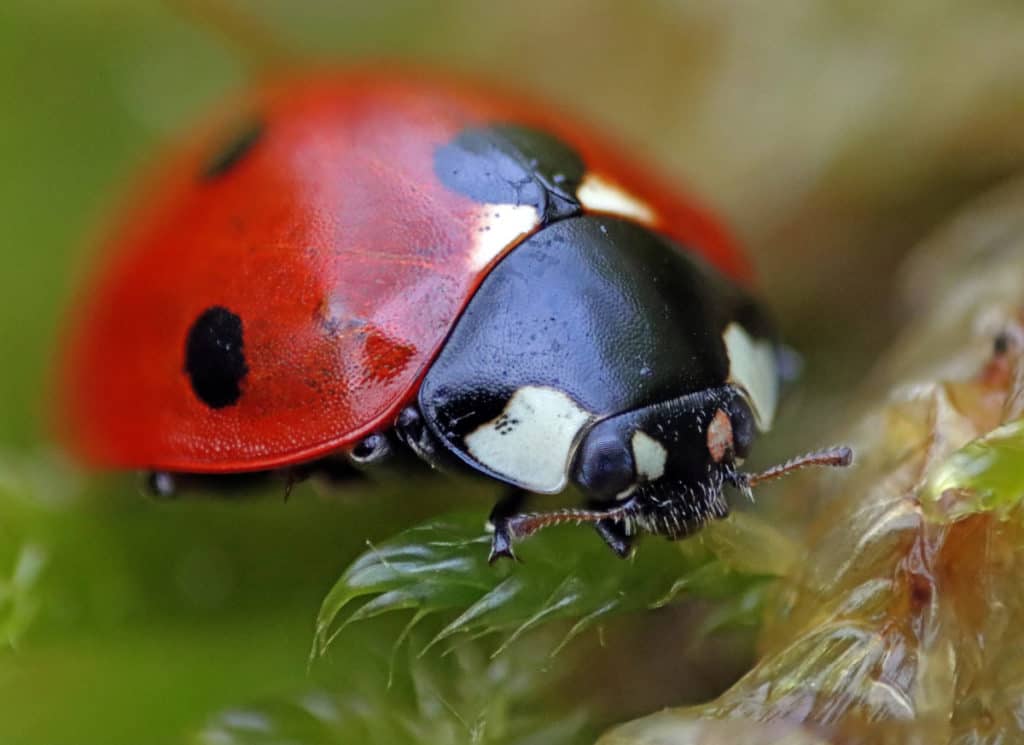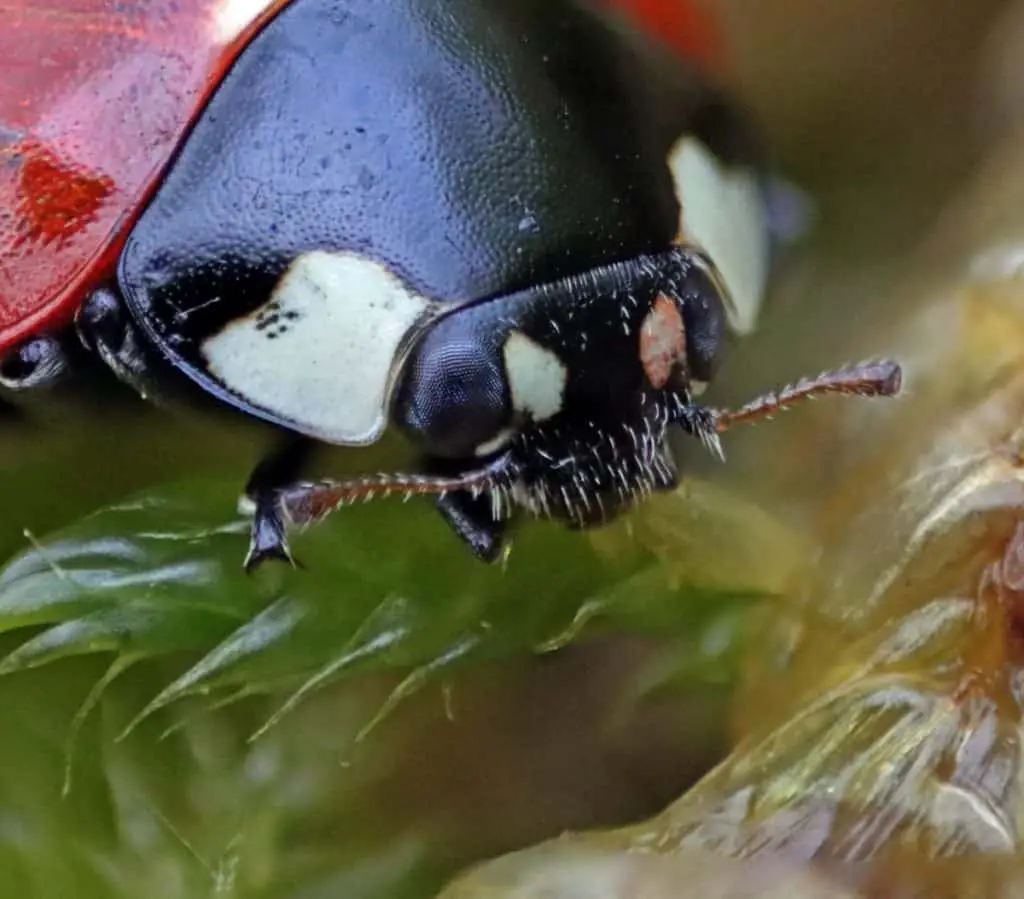Ladybugs are arguably one of the cutest little creatures you will come across. At first glance, it seems that they don’t have antennae as other insects do. So do they in actual fact possess antennae?
Yes, ladybugs have two small antennae. Their antennae have 6 to 11 segments, depending on species, with the last 3 or 4 segments forming a club-like shape. Ladybug antennae are covered in hairs called sensilla. The sensilla make the antennae a sensory hub giving ladybugs their sense of smell, taste, and touch.
Below we will look at the anatomy of the ladybug antennae in detail, how they work, and what they are used for.
The Anatomy Of A Ladybugs Antennae
Although each subspecies of ladybugs differ slightly, each beetle has a pair of what are usually short antennae connected to the head.

These antennae comprise between 6 – 11 segments (depending on the species) with the last three to four segments forming a club-like shape. Each of the segments is freely moving and as with other insect antennas, are grouped into the scape, pedicel, and multiple flagellomeres.
The Scape: Located in the lower portion of the antenna, the scape (dumbbell-shaped) is the longest segment and connects the antenna to the head.
The Pedicel Connects the scape to the first flagellum.
The Flagellum: Located at the furthest end of the antenna, the flagellum consists of 4 – 9 small segments that hold the majority of the sensory organs. The 9th flagellum is the second-longest segment of the ladybug antenna.
The antennal morphology is similar in both male and female ladybugs, although the total length of the male antennae is slightly longer than that of the female, and the segments are slightly wider.
In both sexes, all of the segments are cylindrical and gradually get thicker from the base as they move away from the head.
The antennae of the ladybug are scaly with various types of sensilla distributed along with it.
The Sensory Anatomy Of A Ladybugs Antennae
The sensilla of a ladybug are distributed around the beetle’s body, although those that are located along the antennae play the most vital roles.
These sensilla are responsible for olfactory (smell), tactile (touch), and gustatory (taste) functions.

While there is limited published work on the in-depth morphology of a lady beetle’s antenna, one study has been done to look at the sensilla distributed along with the antennae of the ladybug.
The results from the above study found that a total of six types of sensilla were found along with the antennae. These sensilla include the following:
- Bohm bristle
- Sensilla chaetica
- Sensilla basiconica
- Sensilla trichodea
- Sensilla placodea
- Sensilla coeloconica
Although the density of each of these sensilla is different between subspecies. It was found that the distribution of each was higher along the dorsal surface when compared to the ventral surface.
What Do Ladybugs Use Their Antennae For?
The antennae of a ladybug, as mentioned before is the most important sensory organ on the beetle.
Responsible for numerous uses, the sensilla on these antennae have different functions.
In order to properly understand the function of the antennae, below is a brief description of what each type of sensilla is used for.
The Bohm Bristles
These sensilla, found between the head and the scape, are mechanoreceptors, which monitor and register the movement of the antenna.
Sensilla Chaetica
These sensory organs are the most abundant sensilla on the antennae and within the mouth part. It is suggested that these sensory hairs contact chemosensilla which responds to chemicals in plants and other animals.
In the ladybug, these sensilla are located on the first flagellomere and are believed to be used for the detection of sex pheromones.
Sensilla Basiconica
Seen as the first contact to external material, the sensilla are responsible for chemoreceptive functions, as well as olfactory functions. For example, these odor sensors are used for searching for habitat and food resources.
These sensilla also play a role in recognizing sex pheromones.
Sensilla Trichodea
Located in abundance on the tip of the flagellum, these hairs are responsible for the smell.
These sensilla are used as a primary long-distance olfactory sensor. This includes both sensing food as well as a mate for reproduction.
Sensilla Placodea
This is rare sensilla and only found on the scape of the H. variegata. The function of this sensilla is unknown but presumed to relate to the reception of pheromones and plant volatiles.
Sensilla Coeloconica
These sensilla have been found to be sensitive to water vapor, carbon dioxide, and thermal changes.
As can be seen from the above information, each sensillum is used for a different function, but as a whole, the antennae of a ladybug aid the insect with the location of a mate, the location of food and water (due to smell), connecting information to the insect’s brain, as well as helping them better understand the environment (due to feeling and chemoreceptors) around them.
Another fascinating insect with antennae that are critical to their daily lives is honeybees. We have a detailed article on the honey bee’s super sensory abilities if you are interested. It is called, Bee Antennae, An Amazing Sensory Super Highway
Do All Ladybugs Have Antennae?
While not all ladybugs have antennae, the adult ones do have antennae. Although the antennal structure may differ between ladybug species, with the sensory organs density and distribution changing, as well as the shape and length. A pair of these feelers will always be found.
The only exception to this is when looking at ladybug nymphs or larvae.
Ladybug larvae do not resemble the appearance of an adult ladybug in shape or morphology.
Ladybug nymphs do not have antennae, and will only develop these after their final pupation.
Because of their lack of antenna and other body parts such as wings, the young ladybugs tend to move around less.
Once the insect reaches adulthood it will venture out in search of other habitats and a mate.
The Wrap Up
All adult ladybugs, also known as lady beetles, have a pair of short antennae (although longer antennae are found in some species).
These antennae are broken into three segments: the scape, the pedicel, and multiple flagella.
The antennae of a ladybug function as the main sensory component of the insect, with each antenna consisting of multiple sensory organs known as sensilla.
Without their antennae, ladybugs will have a massive reduction in feel, taste, and touch.
Although a small part of the lady beetle’s anatomy, the antennae are undeniably important to the function and survival of these little colorful insects.
